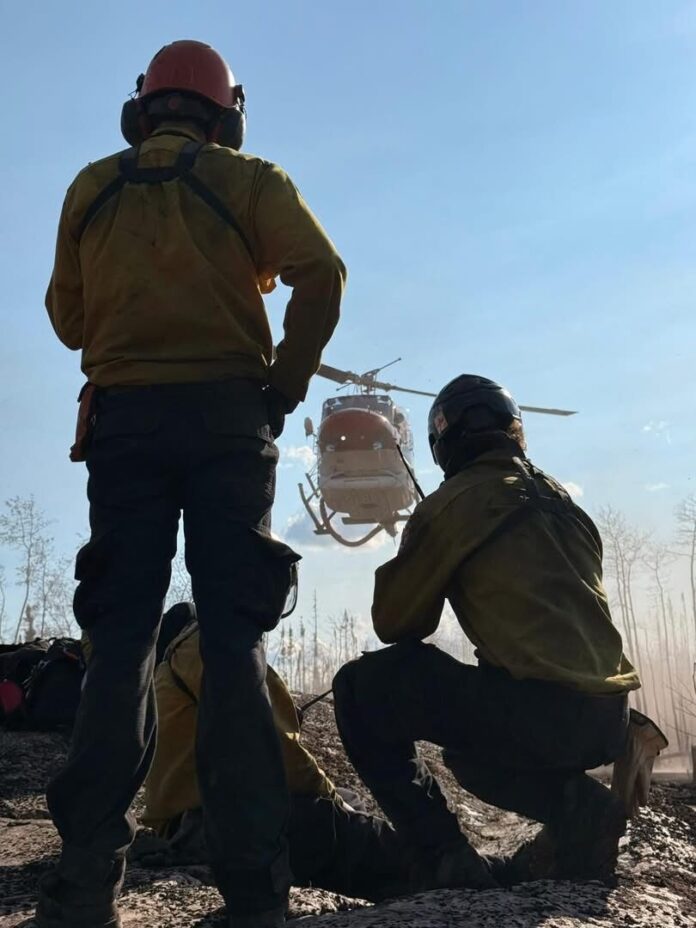Following a focussed, unified response, the Tulip Lake wildfire has been reclassified as held while wildfires in the Sahtu and Dehcho region have grown in size. Officials caution that fire weather conditions continue across the region.
“Warmer weather along with the possibility of dry lightning is expected to continue across most of the NWT in the coming days,” cautioned NWT Fire.
NWT Fire cautioned the public to pay close attention to fire danger weather alerts and to avoid campfires if fire danger is high or extreme. They also urged the public to follow any fire bans in place.
A Full Fire Ban is again in effect for the town of Hay River. The town of Hay River had just recently lifted a fire ban which had been in place for several weeks.
“Due to the current dry conditions, ECC fire rating risk and lack of rain in the upcoming forecast, a fire ban that includes all fire pits is in place until further notice,” cautioned town officials.
NWT Fire assured that wildfires in the NWT do not pose any danger to the public or to structures at this time.
In the South Slave region near the Alta. border, the Tulip Lake wildfire was reclassified to Being Held.
“This classification reflects the confidence of firefighters that the fire will not spread beyond the existing containment lines,” said NWT Fire.
With the progress on the western edges of the Tulip Lake wildfire increased to over 65 per cent containment earlier this week, and crews shifted their focus on the eastern edges.
Crews are using specialized equipment to continue monitoring the edges of the fire.
“Firefighters are continuing to monitor the fire on the west side and will use infrared scans to locate hot spots near the perimeter. They will use water to extinguish these areas and ensure a cold, black perimeter,” said officials.
On the eastern edges, crews continue mopping up areas of heat 30 meters interior of the fire’s edge, working adjacent to the wildfire’s perimeter.
“Firefighters focused their efforts Monday, working to extinguish an ash pit in the northeast corner of the fire. Limited smoke was observed across the fire,” said officials.
The wildfire continues to hold at about 14,167 hectares in size.
The fire began on May 30, located about 5 km northeast of Fort Fitzgerald and 28 km east of Fort Smith. The wildfire is considered held.
Because of the significant decrease in fire activity, crews have begun removing the high-volume sprinkler systems in Fort Smith and Fort Fitzgerald.
A Wildfire Information Bulletin is available daily as this fire operation progresses. NWT asks anyone who would like more details to head to the webpage: https://www.gov.nt.ca/ecc/services/wildfire-update/en/fire/tulip-lake-fire
Also in the South Slave region, another wildfire located about 13km west of Highway 1 in the Cameron Hills is monitored by Fire officials, who said they will deploy structure protection as required.
NWT Fire cautioned that smoke plumes from this fire may continue to be visible from the highway. The fire is burning near an area that burned in 2024, which limits its possibility for growth towards the highway.
This wildfire is 11,358 hectares in size and is considered out of control.
Officials cautioned that smoke may be visible on Highway 1 and urged the public to keep up-to-date on highway conditions at www.driventw.ca.
In the Sahtu region, two lightning-caused fires broke out earlier this week, including one located in the Tu’eyeta area, 92 km south of Fort Good Hope. A few days ago the wildfire had been 39 hectares in size
“This lightning-caused fire has grown to approximately 211 hectares in size. There are currently no threats to communities, cabins, or infrastructure. This fire is currently being monitored,” said NWT Fire.
About 31 km northeast of Délı̨nę and 10 km west of Great Bear Lake, crews are responding to another lightning-caused fire, about 5 hectares in size.
“Crews continue to work on this fire. There are currently no threats to communities, cabins, or infrastructure, cabins in the area are being monitored and structure protection will be set up if needed,” said NWT Fire.
In the Dehcho region, a lightning-caused fire has grown from 10 hectares to nearly 90 hectares in size about 18 km northeast of Wrigley and 1 km north of Hodgson Creek. Crews are actively responding to the wildfire and warned of smoky conditions.
“This lightning-caused fire grown to be approximately 88 hectares in size. Crews continue to work on this fire. There are currently no threats to communities, cabins, or infrastructure, cabins in the area are being monitored and structure protection will be set up if needed. Smoke is being blown away from the community by southeast winds,” said officials.
Anyone who would like more information about air quality can head to GNWT’s air quality site https://www.hss.gov.nt.ca/en/services/environmental-health/air-quality-health-index
A smoke forecast map is available at www.firesmoke.ca
Two new lightning caused fires were also reported in the Dehch, including one that is about 12 hectares in size is located Near Fort Liard and a smaller fire near Naylor’s Landing that is about 0.10 hectares in size according to the last recorded measurements.
For more information about fire danger and to access the live fire map along with detailed updates, head to www.nwtfire.com.





